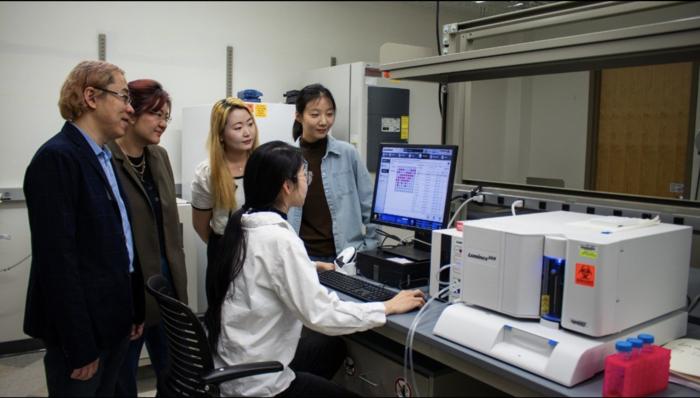UMass Amherst research delegation is in Washington, D.C., for announcement

Credit: INAOE/UMass Amherst
AMHERST, Mass. – Today, in coordinated press conferences across the globe including one at National Science Foundation in Washington, D.C., an international team of astronomers including a team from the University of Massachusetts Amherst reveal that they have succeeded in unveiling the first direct visual evidence of a supermassive black hole and its shadow.
To accomplish this feat, they coordinated eight ground-based radio telescopes around the world to form one Earth-sized Event Horizon Telescope (EHT), an array specially designed and finely networked to capture images of a black hole.
This breakthrough was announced today in a series of six papers published in a special issue of The Astrophysical Journal Letters. The main image reveals the black hole at the center of Messier 87 (M87), a massive galaxy in the nearby Virgo galaxy cluster 55 million light-years from Earth. It has a mass 6.5-billion times that of the Sun.
NSF director France Córdova said, “This is a huge day in astrophysics. We’re seeing the unseeable. Black holes have sparked imaginations for decades. They have exotic properties and are mysterious to us. Yet with more observations like this one they are yielding their secrets. This is why NSF exists. We enable scientists and engineers to illuminate the unknown, to reveal the subtle and complex majesty of our universe.”
The EHT used telescopes at the South Pole and in Chile, Mexico, Spain, Hawaii and Arizona. The instrument array includes the Large Millimeter Telescope (LMT) in Mexico, operated jointly by the University of Massachusetts Amherst and Mexico’s Instituto Nacional de Astrofísica, Óptica y Electrónica. Astronomy professor Gopal Narayanan, principal investigator for UMass Amherst’s EHT mission, specializes in building spectroscopic imaging instruments and led the team building two radio astronomy receivers used to collect EHT data at the LMT. Because of its central geographical location and large aperture, the LMT has been critical to the success of the EHT array, Narayanan says.
Also in the UMass Amherst delegation in Washington today are Vice Chancellor for Research and Engagement Michael Malone, UMass Amherst’s LMT principal investigator professor Peter Schloerb and astronomy graduate student Aleks Popstefanija. The UMass Amherst astronomers are co-authors on all six papers being released today.
Narayanan points out that one of the exciting areas of modern astrophysics is the notion that in and around the singularity of space-time of black holes, the macroscopic world collides with the microscopic world. For example, physicist Stephen Hawking has conjectured that black holes are ideal laboratories where the concepts of quantum mechanics and general relativity can be melded into a grand unified theory of fundamental concepts.
Narayanan says, “The place to study that is at the event horizon of a black hole. By detecting this one, we get to the point where we can test some of these theories and start to identify the fundamental laws that order the universe.”
The EHT observations allowed astronomers to look at the very heart of a super massive black hole and the event horizon surrounding it. As Hawking pointed out, material falling into a black hole poses an “information paradox,” because the information carried in the particles falling into the black hole seem forever lost to the universe. “That goes against the conservation laws of physics,” Narayanan says. Future EHT observations may be able help test some of the interesting theories on the problem of information paradox.
The EHT observations reveal the image of black hole at the center of Messier 87 (M87), a massive galaxy in the nearby Virgo galaxy cluster. This black hole is 55 million light-years from Earth and has a mass 6.5 billion times that of the Sun. The new M87 event horizon image shows an asymmetric ring-like structure around a central dark region. Theories predicted that the massive gravitational potential of the central super-massive black hole would bend and capture the light emanated from the hot gas swirling at near the speed of light around the event horizon of the black hole, Narayanan explains.
He adds, “The experiment was set up so that we expected to see this happen and, by golly, we did! These observations are the million-dollar images that confirm the theory.” This experiment also yielded the first best evidence that super massive black holes exist at a size of not just 20 or 30 solar masses, but millions and billions of solar masses. The observations indicated a 6.5 billion solar mass object within the confines of the event horizon imaged.
Together, the discoveries give “a shot in the arm to theorists,” Narayanan points out, because it lets them test which of their ideas is supported by observable evidence. “It’s very gratifying and immensely exciting to see the results coming out after years of work,” he adds. “At times it looked like an impossible task. But we showed that you can collaborate on this scale and get results. The camaraderie and team spirit was a wonderful thing to see.”
Further, “During the stress and strain of observing at night and in the cold, there were jokes amidst all the technical problems. I’d be helping someone out in Hawaii or Chile while we discussed some technical issues online. It wasn’t just telescopes collaborating, it was a lot of young people, women, minorities, many people doing a lot of hard work. It’s been an amazing effort.”
###
Media Contact
Janet Lathrop
[email protected]





